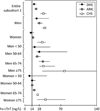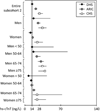Age- and sex-dependent upper reference limits for the high-sensitivity cardiac troponin T assay
- PMID: 24530665
- PMCID: PMC3984900
- DOI: 10.1016/j.jacc.2013.12.032
Age- and sex-dependent upper reference limits for the high-sensitivity cardiac troponin T assay
Abstract
Objectives: The study sought to determine the 99th percentile upper reference limit for the high-sensitivity cardiac troponin T assay (hs-cTnT) in 3 large independent cohorts.
Background: The presently recommended 14 ng/l cut point for the diagnosis of myocardial infarction using the hs-cTnT assay was derived from small studies of presumably healthy individuals, with relatively little phenotypic characterization.
Methods: Data were included from 3 well-characterized population-based studies: the Dallas Heart Study (DHS), the Atherosclerosis Risk in Communities (ARIC) Study, and the Cardiovascular Health Study (CHS). Within each cohort, reference subcohorts were defined excluding individuals with recent hospitalization, overt cardiovascular disease, and kidney disease (subcohort 1), and further excluding those with subclinical structural heart disease (subcohort 2). Data were analyzed stratified by age, sex, and race.
Results: The 99th percentile values for the hs-cTnT assay in DHS, ARIC, and CHS were 18, 22, and 36 ng/l (subcohort 1) and 14, 21, and 28 ng/l (subcohort 2), respectively. These differences in 99th percentile values paralleled age differences across cohorts. Analyses within sex/age strata yielded similar results between cohorts. Within each cohort, 99th percentile values increased with age and were higher in men. More than 10% of men 65 to 74 years of age with no cardiovascular disease in our study had cardiac troponin T values above the current myocardial infarction threshold.
Conclusions: Use of a uniform 14 ng/l cutoff for the hs-cTnT assay may lead to over-diagnosis of myocardial infarction, particularly in men and the elderly. Clinical validation is needed of new age- and sex-specific cutoff values for this assay.
Keywords: diagnosis; myocardial infarction; population; troponin.
Copyright © 2014 American College of Cardiology Foundation. Published by Elsevier Inc. All rights reserved.
Figures


Comment in
-
Avoiding the imminent plague of troponinitis: the need for reference limits for high-sensitivity cardiac troponin T.J Am Coll Cardiol. 2014 Apr 15;63(14):1449-50. doi: 10.1016/j.jacc.2013.12.031. Epub 2014 Feb 12. J Am Coll Cardiol. 2014. PMID: 24530670 No abstract available.
References
-
- Wu AH, Jaffe AS. The clinical need for high-sensitivity cardiac troponin assays for acute coronary syndromes and the role for serial testing. Am Heart J. 2008;155:208–214. - PubMed
-
- Reichlin T, Hochholzer W, Bassetti S, et al. Early diagnosis of myocardial infarction with sensitive cardiac troponin assays. N Engl J Med. 2009;361:858–867. - PubMed
-
- Apple FS, Collinson PO. Analytical characteristics of high-sensitivity cardiac troponin assays. Clin Chem. 2012;58:54–61. - PubMed
-
- Thygesen K, Mair J, Giannitsis E, et al. How to use high-sensitivity cardiac troponins in acute cardiac care. Eur Heart J. 2012;33:2252–2257. - PubMed
-
- Korley FK, Jaffe AS. Preparing the United States for High-Sensitivity Cardiac Troponin Assays. J Am Coll Cardiol. 2013;61:1753–1758. - PubMed
Publication types
MeSH terms
Substances
Grants and funding
- HHSN268201100012C/HL/NHLBI NIH HHS/United States
- HHSN268201100005G/HL/NHLBI NIH HHS/United States
- R56 AG020098/AG/NIA NIH HHS/United States
- AG-20098/AG/NIA NIH HHS/United States
- N01-HC-85086/HC/NHLBI NIH HHS/United States
- AG-027058/AG/NIA NIH HHS/United States
- R01 HL080295/HL/NHLBI NIH HHS/United States
- UL1-TR000451/TR/NCATS NIH HHS/United States
- R01 AG020098/AG/NIA NIH HHS/United States
- HHSN268201100005C/HL/NHLBI NIH HHS/United States
- N01-HC-85079/HC/NHLBI NIH HHS/United States
- R01 AG015928/AG/NIA NIH HHS/United States
- UL1 TR001105/TR/NCATS NIH HHS/United States
- U01 HL080295/HL/NHLBI NIH HHS/United States
- N01 HC015103/HC/NHLBI NIH HHS/United States
- N01 HC085086/HL/NHLBI NIH HHS/United States
- UL1 TR000451/TR/NCATS NIH HHS/United States
- N01 HC-55222/HC/NHLBI NIH HHS/United States
- N01 HC055222/HL/NHLBI NIH HHS/United States
- HHSN268201100005I/HL/NHLBI NIH HHS/United States
- N01 HC085079/HL/NHLBI NIH HHS/United States
- N01-HC-75150/HC/NHLBI NIH HHS/United States
- T32 HL007360/HL/NHLBI NIH HHS/United States
- N01-HC-85239/HC/NHLBI NIH HHS/United States
- AG-023629/AG/NIA NIH HHS/United States
- N01 HC075150/HL/NHLBI NIH HHS/United States
- R01 AG023629/AG/NIA NIH HHS/United States
- R01 AG027058/AG/NIA NIH HHS/United States
- N01 HC045133/HC/NHLBI NIH HHS/United States
- N01 HC035129/HC/NHLBI NIH HHS/United States
- R56 AG023629/AG/NIA NIH HHS/United States
LinkOut - more resources
Full Text Sources
Other Literature Sources
Medical
Research Materials
Miscellaneous

